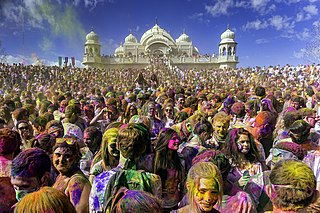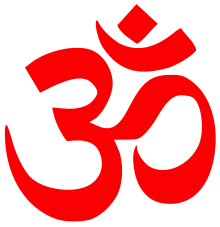The following outline is provided as an overview of and topical guide to Hinduism:

Hinduism has been found in the Middle East since the mid-19th century. Millions of members of the Indian diaspora, of different religions, reside and work in Arab states of the Persian Gulf; many of them are Hindu. Many came due to the migration of Indians and Nepalese expatriates and employees to the area around the Persian Gulf.

Vrindavan, also spelt Vrindaban and Brindaban, is a historical city in the Mathura district of Uttar Pradesh, India. It is located in the Braj Bhoomi region and holds religious importance in Hinduism as it is believed in Hinduism that Krishna spent most of his childhood days in this city. Vrindavan has about 5,500 temples dedicated to the worship of Krishna and his chief consort Radha.

Hinduism is practised by 1.7% of the population of Myanmar. Hinduism is practised by about 890,000 people in Myanmar, and has been influenced by elements of Buddhism, with many Hindu temples in Myanmar housing statues of the Buddha. There are also a large population of Hindus in which the Myanmar Tamils and minority Bengali Hindus having the biggest population share.

Hinduism is a minority religion constituting about 0.15% of the population of Austria. Hinduism is not one of the 16 recognised religions in Austria. The Austrian law allows religious groups not recognized as societies to seek official status as confessional communities with the Office for Religious Affairs. Hinduism is one of the eight confessional communities in Austria. However the Sahaja Yoga and the International Society for Krishna Consciousness are categorised as associations, not as a confessional communitIES.

Hinduism is the fourth-largest religion in the United States of America, constituting 1% of the population, equaling Islam and Buddhism percentage wise. The vast majority of American Hindus are immigrants mainly from India, some from Nepal, Sri Lanka, and Bangladesh, and a minority from Bhutan, Pakistan and Afghanistan. Additionally, the United States has a number of converts to Hinduism.

Hinduism is currently practiced by a minority of residents of China. The religion itself has a very limited presence in modern mainland China, but archaeological evidence suggests a significant presence of Hinduism in different provinces of medieval China. Hindu influences were also absorbed in to Buddhism and got mixed with Chinese mythology over its history. Practices originating in the Vedic tradition of ancient India such as yoga and meditation are also popular in China.
The following list consists of notable concepts that are derived from Hindu culture and associated cultures traditions, which are expressed as words in Sanskrit or other Indic languages and Dravidian languages. The main purpose of this list is to disambiguate multiple spellings, to make note of spellings no longer in use for these concepts, to define the concept in one or two lines, to make it easy for one to find and pin down specific concepts, and to provide a guide to unique concepts of Hinduism all in one place.

Hinduism is a minority religion in Japan mainly followed by the Indian and Nepali expatriate residents of Japan, who number about 166,550 people as of 2022.

Hinduism is the third-largest religion in Canada, which is followed by approximately 2.3% of nation's total population. As of 2021, there are over 828,000 Canadians of the Hindu faith.
Sri Sri Radha Krishna temple is one of the most important Hindu temples in South Korea. It belongs to the Vaishnavite ISKCON movement. The temple is located in the Uijeongbu city of Gyeonggi Province. It holds many lecture seminars and Yoga classes for Hindu devotees living in nearby areas.
Sri Radha Shyamasundar Mandir is a Hindu temple located in Haebangchon, Seoul, South Korea. The temple opens each morning and evening at specific darshan times. Special programs are also held on Sundays, such as free children's Bal Vikas classes, yoga classes, and a special Sunday feast program with Bhagavad Gita lectures.

Hinduism is one of the fastest growing religions in Northern Ireland with over 4,000 Hindus in the country, making up 0.22% of the population. There are currently 3 Mandirs in Belfast alone: Radha-Krishna Temple in Malone Road, Laxmi-Narayan Mandir in Clifton Street and Radha Madhava Mandir (ISKCON) in Upper Dunmurry Lane. There is also a Hare Krishna Centre on Inish Rath Island that was established in 1985.

ISKCON Vrindavan, also called Sri Sri Krishna Balaram Mandir, is one of the major ISKCON temples in the world. It is a Gaudiya Vaishnava temple located in the city of Vrindavan, Mathura district, in the Indian state of Uttar Pradesh. The temple is dedicated to the Hindu gods Krishna and Balarama. The other deities of temple are Radha Krishna and Gauranga Nityananda.
Hindu denominations, sampradayas, traditions, movements, and sects are traditions and sub-traditions within Hinduism centered on one or more gods or goddesses, such as Vishnu, Shiva, Shakti and so on. The term sampradaya is used for branches with a particular founder-guru with a particular philosophy.
Sri Lakshmi Narayanan Temple is a Hindu temple located in the metropolitan city of Seoul. This temple is dedicated to lord Vishnu. The temple serves as the cultural and religious center for Korean Hindus and immigrants from South Asian countries. Devotees visit this temple to fulfil their religious rituals and organise traditional programs related to Yoga and Vedanta.
Himalayan Meditation and Yoga Sadhana Mandir is a Hindu temple located in the Seocho district of Seoul metropolitan city. It is an affiliate center of Association of Himalayan Yoga Meditation Societies International organisation in South Korea. The temple offers various classes and training programs on different Meditation and Yoga practices to the local Hindu and Korean communities. The temples maintains various centers across the Korean peninsula.











